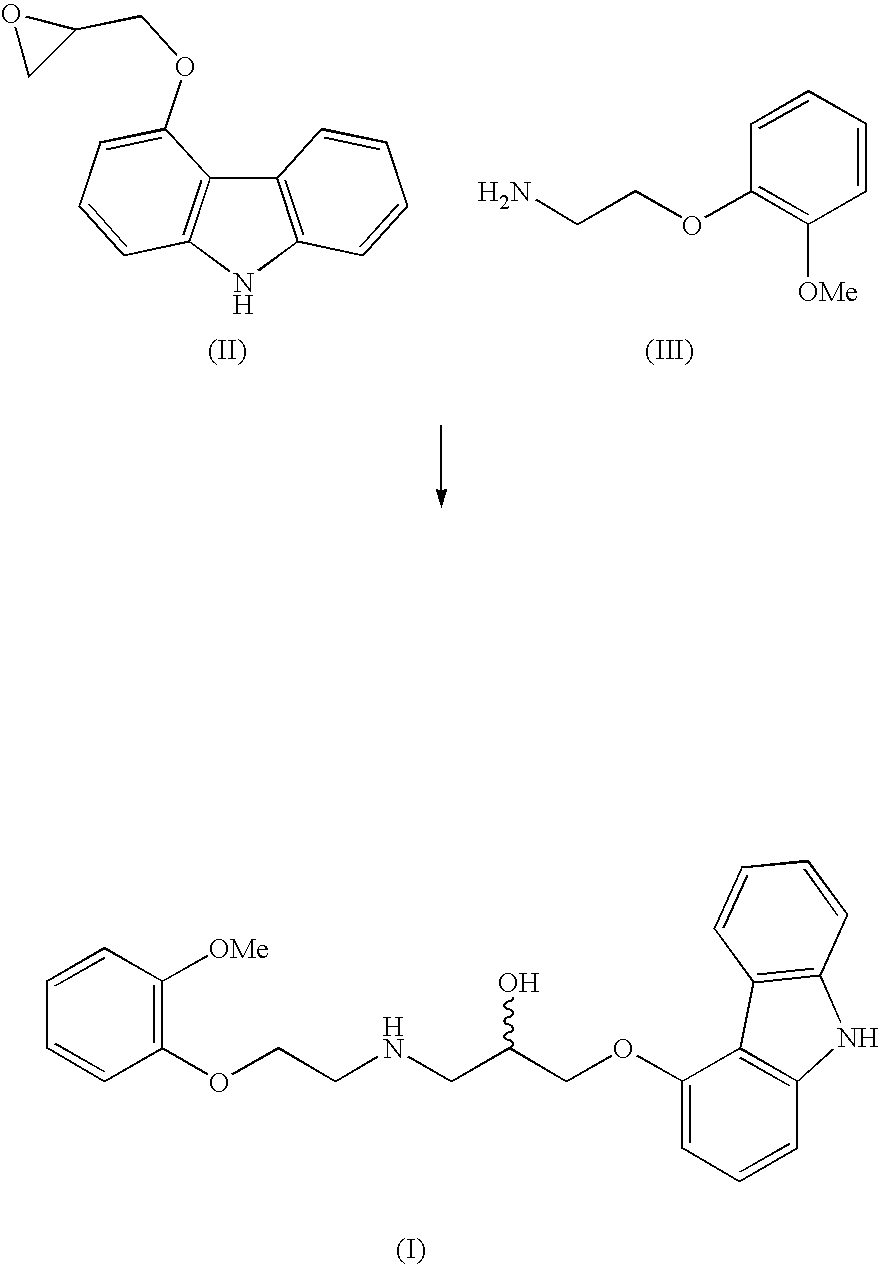Process for preparation of carvedilol
a technology of carvedilol and carvedilol, which is applied in the field of synthesis and purification of the active substance of carvedilol, can solve the problems of increased carvedilol, low yield of carvedilol, and additional steps, and achieves the effect of increasing technical and economic requirements
- Summary
- Abstract
- Description
- Claims
- Application Information
AI Technical Summary
Benefits of technology
Problems solved by technology
Method used
Image
Examples
example 1
[0014]To a mixture of 5.0 kg anhydrous potassium carbonate and 7.5 kg of 2-(2-methoxyphenoxy)ethylamine hydrogenchloride monohydrate (IV) in 32 liters of isopropanol, mixed at a temperature of 35° C. for 15 min., are added 3.87 kg of 4-(oxirane-2-ylmethoxy)-9H-carbazole (II) and the mixture is, with intensive stirring, heated at 83° C. for 5 hours. After the epoxide has reacted, the reaction mixture is filtered, isopropanol is distilled off and the residue is diluted in 20 l ethylacetate. The obtained solution is cooled, inoculated and stirred at the temperature of 35° C. for 30 minutes. After the crystal precipitates, the mixture is cooled to 5° C. and stirred for four hours. The crystallised raw Carvedilol is centrifuged and washed with cooled ethylacetate (HPLC contents>98 area %, HPLC contents of the bis-derivative 1.2-1.5 area %).
[0015]The moist, crude Carvedilol is diluted at a temperature of 55 to 65° C. in 30 l ethylacetate, 0.8 kg of activated carbon is added, and stirred f...
example 2
[0017]A mixture of 9.7 g 4-(oxirane-2-ylmethoxy)-9H-carbazole (II), 53.7 g of anhydrous hydrogen sulphate of 2-(2-methoxyphenoxy)ethylamine (III) and 28 g of anhydrous potassium carbonate in 200 ml isopropanol are, with intensive stirring, heated at 80° C. for six hours. When the epoxide has reacted, the mixed salts are filtered off from the reaction mixture and isopropanol is distilled off from the filtrate. The obtained honey-like concentrate is diluted with heating in 50 ml of ethylacetate, the solution is cooled to the temperature of 40° C., it is inoculated and stirred at the temperature of 40° C. for two hours. After the crystal precipitates, the mixture is cooled to the temperature of 0° C., and is kept like that with stirring for a minimum of four hours. After filtration and washing with cooled ethylacetate, 5.2 g of wet, crude Carvedilol is obtained (HPLC contents 95.2 area %, HPLC contents of the bis-derivative 2.8 area %).
example 3
[0018]A mixture of 43.2 g 4-(oxirane-2-ylmethoxy)-9H-carbazole (II), 80.0 g of 2-(2-methoxyphenoxy)ethylamine hydrogenchloride monohydrate (IV) and 52.4 g of anhydrous calcium carbonate in 330 ml isopropanol is, with intensive stirring, heated at 80° C. for 4 hours. When the epoxide has reacted, the mixed salts are filtered off from the reaction mixture and isopropanol is distilled off from the filtrate. The obtained honey-like concentrate is dissolved, when hot, in 210 ml of ethylacetate, the solution is cooled to the temperature of 40° C., inoculated and stirred at the temperature of 40° C. for 30 minutes. After the crystal precipitates, the mixture is cooled to 0° C., and is kept like that with stirring for a minimum of four hours. After filtration and washing with cooled ethylacetate, 65 to 70 g of wet crude Carvedilol is obtained (HPLC contents>98 area %, HPLC contents of the bis-derivative 1.2-1.5 area %).
PUM
| Property | Measurement | Unit |
|---|---|---|
| reaction temperature | aaaaa | aaaaa |
| temperature | aaaaa | aaaaa |
| temperature | aaaaa | aaaaa |
Abstract
Description
Claims
Application Information
 Login to View More
Login to View More - R&D
- Intellectual Property
- Life Sciences
- Materials
- Tech Scout
- Unparalleled Data Quality
- Higher Quality Content
- 60% Fewer Hallucinations
Browse by: Latest US Patents, China's latest patents, Technical Efficacy Thesaurus, Application Domain, Technology Topic, Popular Technical Reports.
© 2025 PatSnap. All rights reserved.Legal|Privacy policy|Modern Slavery Act Transparency Statement|Sitemap|About US| Contact US: help@patsnap.com


